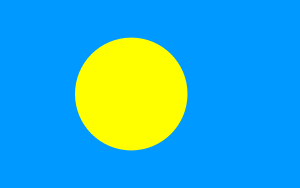Flag of Palau facts for kids
The flag of Palau is the official national symbol of this island nation. It was created in 1981 when Palau became a self-governing country. The flag's design is simple but full of meaning for the people of Palau.
What the Flag Looks Like
The flag of Palau has a bright, light blue background. This blue color represents the vast Pacific Ocean that surrounds the islands, as well as the nation's independence and its place in the world.
In the middle of the flag, but shifted a little bit towards the left side (called the hoist-side), there is a large, golden yellow disk. This disk is not meant to be the sun. Instead, it represents the full moon.
Meaning of the Moon
The full moon is very important in Palauan culture. It symbolizes peace, calmness, and love. It's also a time when many traditional activities happen, like fishing, planting, and celebrating. The moon brings a sense of timing and prosperity to the islanders' lives.
History of the Flag
Before 1981, Palau was part of the Trust Territory of the Pacific Islands, managed by the United States. When Palau gained more control over its own government, it needed its own national flag. Many designs were suggested, but the current design was chosen because it best represented the country's unique culture and hopes for the future.
The flag was designed by a local artist named Blau Skebong. It was officially adopted on January 1, 1981, marking an important step in Palau's journey to becoming an independent nation.
Images for kids
-
Palau team at the 2008 Summer Olympics with the flag.
See also
 In Spanish: Bandera de Palaos para niños
In Spanish: Bandera de Palaos para niños




